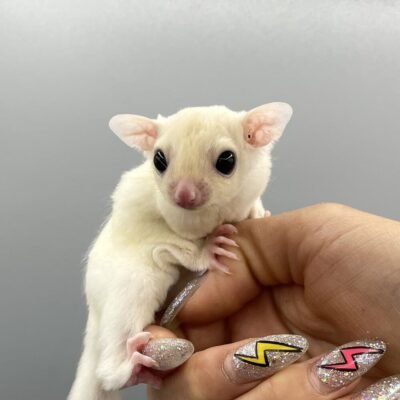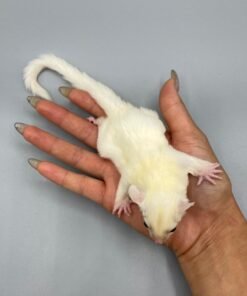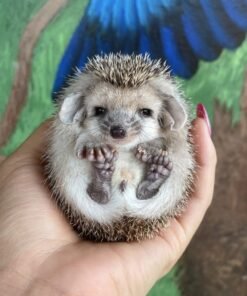MALE SUGAR GLIDER FOR SALE
$650.00
MALE SUGAR GLIDER FOR SALE

The Male Sugar Glider: Gliders on the Go, But Not Quite Family Men
Male sugar gliders are fascinating creatures with distinct characteristics and behaviors that complement the social structure of their colonies. Here’s a breakdown of what makes them unique:
Appearance:
- Matchmaker, Matchmaker: Males generally resemble females in size and overall appearance. They have a squirrel-like body with soft, gliding fur, typically grey or brown with black stripes. Their most distinctive feature, the patagium, is a furry membrane stretching from their wrists to their ankles, allowing them to glide between trees.
- Subtle Differences: In some species, males may be slightly larger than females. You might need a very close look to tell the difference, though! One potential clue is the scent gland.
Scent Gland:
- Marking Territory: Unlike females, males have a scent gland located on their forehead. This gland appears as a small bald spot and is used to mark their territory and potentially communicate with other sugar gliders.
Social Behavior:
- Lone Wolves (Sort Of): Male sugar gliders tend to be solitary creatures outside of mating season. They have overlapping territories with several females and may not interact with other males or females very often, except during breeding. This solitary lifestyle helps to minimize competition for food resources within the colony.
- Dominant Demeanor: In some sugar glider colonies, males may exhibit dominance hierarchies. Larger and older males may have priority access to mates and preferred feeding areas.
Reproduction:
- Mating Season: Similar to females, males can breed throughout the year, although breeding is more frequent during specific seasons depending on location and climate.
- Mating Rituals: During breeding season, males may engage in courtship behaviors to attract females. These can include scent marking, vocalizations, and gliding displays.
- No Diaper Duty: After mating, the male plays no role in raising the young. The responsibility of caring for the joeys falls solely on the females and other females within the colony.
Importance to the Colony:
- Genetic Diversity: While they don’t participate in raising young, male sugar gliders play a vital role in ensuring genetic diversity within the colony. Competition among males during breeding season can lead to stronger genes being passed on to the next generation. small pets for sale
Threats and Conservation:
- Habitat Loss: Like females, male sugar gliders face threats like habitat loss due to deforestation.
- Importance of Conservation: Understanding the roles of both males and females is crucial for sugar glider conservation efforts. Protecting their habitat and promoting sustainable practices is essential for the survival of these amazing creatures.
By understanding the unique characteristics and behaviors of both male and female sugar gliders, we can appreciate the complexity of their social structure and their importance within the ecosystem. sugar glider pet for sale

MALE SUGAR GLIDER FOR SALE

Male Sugar Glider: Detailed Overview
Scientific Classification:
- Scientific Name: Petaurus breviceps
- Family: Petauridae
General Description
The male sugar glider is a small, nocturnal marsupial native to Australia, New Guinea, and some surrounding islands. Known for their ability to glide and their social nature, sugar gliders are popular exotic pets.
Physical Characteristics

- Size and Appearance
- Weight: Typically between 100 to 160 grams (3.5 to 5.6 ounces), slightly heavier than females.
- Length: Body length ranges from 12 to 17 cm (5 to 7 inches), with a tail length of approximately 15 to 20 cm (6 to 8 inches). MALE SUGAR GLIDER FOR SALE
- Fur: Soft, silky fur that is generally grey with a black dorsal stripe and a lighter underbelly. Some color variations exist.
- Eyes: Large, dark eyes adapted for night vision.
- Gliding Membrane: The patagium, a membrane stretching from the wrists to the ankles, allows them to glide between trees. healthy and trained sugar gliders
- Scent Glands: Male sugar gliders have scent glands on the top of their head and chest, which they use for marking territory and identifying group members. sale healthy and trained
Habitat
-
Geographic Range: Native to forests and woodlands in Australia, New Guinea, and surrounding islands.
- Preferred Environment: Prefer eucalyptus forests and other wooded areas where they can glide from tree to tree in search of food. male sugar glider for sale
Behavior and Lifestyle
- Activity Patterns
- Nocturnal: Active primarily at night, foraging for food and socializing.
- Diurnal Resting: Spend the day sleeping in nests made of leaves and bark inside tree hollows.
- Diet
- Omnivorous: Their diet includes nectar, sap from eucalyptus and acacia trees, fruits, insects, and small vertebrates. They have a particular preference for sweet substances like sap and nectar.
- Social Structure
- Highly social animals that live in groups, called colonies, of up to 7 individuals. They communicate through a variety of vocalizations, scent marking, and body language.
Reproduction

- Breeding
- Male sugar gliders reach sexual maturity at around 12 months of age.
- Breeding can occur year-round, though in the wild, it often aligns with food availability.
- The gestation period is about 15 to 17 days, after which the tiny, underdeveloped young (joey) crawls into the mother’s pouch to continue developing. trained sugar gliders for sale
- Parental Care
- The joey remains in the mother’s pouch for about 60 to 70 days, followed by another 30 to 40 days of riding on the mother’s back until fully weaned.
- While the mother is primarily responsible for caring for the young, male sugar gliders may help protect the colony and participate in social grooming.
Adaptations
- Gliding Ability
- The patagium allows sugar gliders to glide distances of up to 50 meters (160 feet) between trees, aiding in foraging and evasion of predators.
- Night Vision
- Large eyes enhance their ability to see in low light, aiding in nocturnal activities.
- Scent Glands
- The scent glands on the head and chest are used for marking territory and social bonding within their group.
Conservation Status
- Threats
- Habitat destruction due to deforestation and land development poses a significant threat.
- Predation by introduced species such as cats and foxes.
- Conservation Efforts
- Efforts include habitat preservation, reforestation projects, and legal protections in some areas to prevent capture and sale in the pet trade. sugar glider for sale
Interesting Facts
- Social Creatures
- Male sugar gliders thrive in social environments and can become stressed if isolated.
- They engage in mutual grooming, which helps reinforce social bonds.
- Unique Diet
- Their diet in the wild is diverse and requires careful replication in captivity to ensure their health, with a need for calcium and a balance of fruits, insects, and specialized nectar.
- Nocturnal Nature
- Adapted to a nocturnal lifestyle, they are most active at night when foraging for food and interacting with their group members.
Conclusion
Male sugar gliders are fascinating marsupials with unique adaptations for their arboreal and nocturnal lifestyle. Their social nature, gliding ability, and complex dietary needs make them both intriguing and challenging to care for in captivity. where to buy a sugar glider, Conservation efforts are essential to protect their natural habitats and ensure the survival of these remarkable animals in the wild. Understanding the behavior, diet, and environmental needs of male sugar gliders enhances our appreciation and ability to care for them responsibly.

Reviews
There are no reviews yet.
Related products
Exotic Cubs For Sale
Exotic Cubs For Sale
Hedgehog
Exotic Cubs For Sale
Exotic Cubs For Sale
Exotic Tortoises For Sale
Exotic Cubs For Sale
Exotic Cubs For Sale



















Be the first to review “MALE SUGAR GLIDER FOR SALE ”